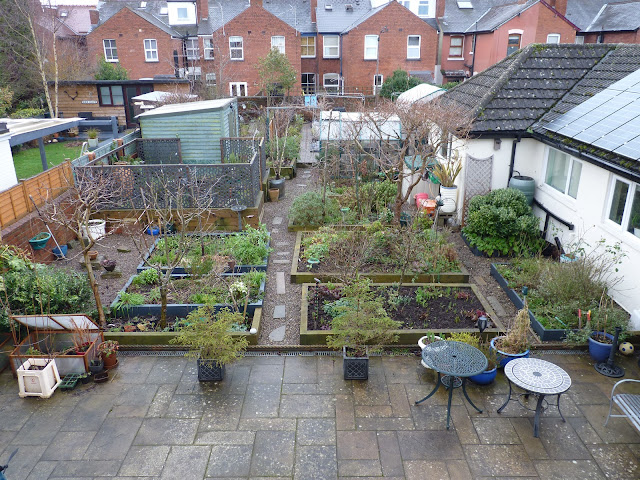When we bought the house in November 2001, it still retained many of the features of its previous use as a small residential home. Apart from the walk-in shower, plethora of fire doors and working 'Smash Glass' red boxes for the fire alarm system, there were 2 gas boilers (one for the residents and one for the live-in owners). The 'red boxes' are now purely ornamental (replaced with a modern wi-fi connected mains alarm system with battery back-up) and the gas boilers have gone for recycling.

The original wall-mounted gas boilers were replaced with newer more efficient models around 2005 but it still meant two boilers and two annual maintenance bills for upkeep and safety checks. The annual gas check in 2018 identified issues with the original gas pipework (too narrow to supply sufficient pressure to both gas boilers and the two gas fires although no operational issues had been noted in the previous 13-14 years of servicing). The gas fires were immediately disconnected and we endured a couple of cold rooms during the 2018/19 winter before deciding to go fully electric on a renewable energy tariff in November 2019.
We used a local company, Caplor Energy, to investigate Air Source Heat Pumps (ASHPs) and booked installation for the beginning of January 2020. The two gas boilers were replaced with two ASHPs (Mitsubishi Ecodan 8.3 kW and 14 kW units) along with new hot water cylinders pre-plumbed to take advantage of our two solar water heating systems. Work started on 6th January 2020 and the ASHPs were switched on at noon on the 10th January. We needed one new radiator and two replacement radiators but otherwise minimal upgrading of the wet heating system. There is always the option of upgrading the other radiators at a later date; so far, that does not seem to be necessary.

The ASHP units were placed on brackets above the drive/parking area so we did not lose our off-road parking (a valuable commodity in Hereford). This was also close to where the main gas boiler had been so simplified the plumbing requirements. There is some noise from the units (a loud whisper) when outside and a small amount of vibrational noise when they are operating. Ideally, ASHPs would be placed on the ground and away from the house to minimise any noise/vibration issues.
The hot water cylinders look busy - more so in this case because they are plumbed to take the solar thermal water heating we had installed 15 years ago and they had to be squeezed into existing cupboard space.
The ASHPs are fully programmable for heating and hot water so not too different to a gas boiler system. However, because the temperature of the hot water in the radiators is lower than for a gas-fired system, ASHPs are programmed to run continuously although that doesn't mean they are running all the time. Typically, ours are programmed to run at 16℃ overnight and at 19℃ during the day; the house is sufficiently well insulated that the pumps operate infrequently overnight even in winter. In summer, the vast majority of hot water is provided by the solar thermal and the heating is not triggered by the thermostat/programmer.
The programmer/controller/thermostat is situated adjacent to the hot water cylinder and this is not optimal. Additional room thermostats/controllers are available. One of the hot water cylinders is downstairs in a single storey annex so the location of the room thermostat is fine. However, the thermostat/controller for the main house is upstairs; this means upstairs is too hot when the downstairs temperature is comfortable or the downstairs temperature is too low if the upstairs temperature is comfortable. Adding a second mobile thermostat for downstairs helps though there is still a tendency for upstairs to be too warm (hot air rises).
On the 10th January 2021, the ASHPs had been running for exactly one year using 13500 kWh of electricity at a cost of about £1900. In 2018 and 2019, our yearly energy consumption was remarkably constant at 20,000 kWh gas and 7000 kWh electricity. This equates to energy bills (heating, hot water and electrical appliances) of £1580 (gas & electricity, 2018), £1740 (gas & electricity, 2019) and £1900 (electricity only, 2020) or an increase of about 10% per year. On this basis, the running costs of the ASHPs are similar to those of the previous gas system with the added advantages of warmer rooms and constant hot water. Some savings arise from not having a gas meter as the daily standing charge can cost between £50-£150 per year depending on the energy supplier. I also have solar PV installed which adds further savings by converting 1kWh of solar into 2 - 3 kWh of heat.
In April 2021, I finally changed my electricity supplier from Scottish Power to Good Energy. Scottish Power produce all their own renewable energy (wind farms) and do not rely on 'greenwashing' (buying ROCs to offset their renewable energy quota rather than producing the renewable energy or buying it from a renewable energy producer). Unfortunately, their customer service is abyssmal (note: the actual customer service agents were pleasant and helpful). I had to query virtually every quarterly bill as they continued to bill me for gas even after I had them remove the gas meter. Good Energy are more expensive but are considered to be one of the 'greenest' suppliers by the Energy Saving Trust.




















